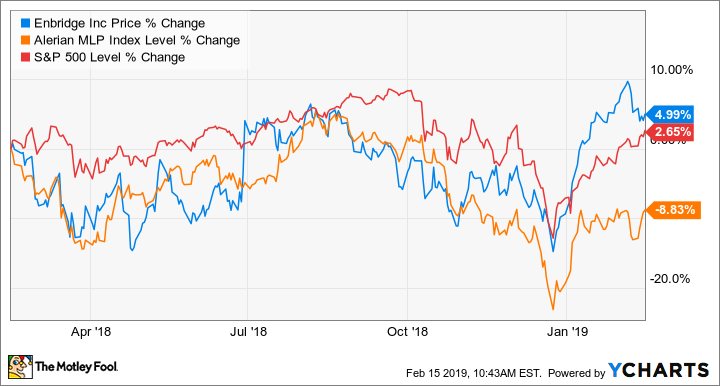Considering that Enbridge (ENB 0.87%) has completed several billion dollars in asset sales in recent quarters and consolidated all of its subsidiary partnerships under one roof, this was a rather impressive fourth quarter. The company saw a significant boost to its bottom line thanks to several major capital projects going live this past year, and now management has laid out a plan to keep up that pace for several years.
Here's a brief rundown of Enbridge's most recent results and what irons management has in the fire to keep the North American energy infrastructure giant growing well into the future.
Enbridge's results: The raw numbers
| Metric | Q4 2018 | Q3 2018 | Q4 2017 |
|---|---|---|---|
| Revenue | CA$11.56 billion | CA$11.34 billion | CA$12.88 billion |
| Earnings attributable to common shareholders (loss) | CA$1.08 billion | (CA$90 million) | CA$207 million |
| Diluted EPS diluted | CA$0.60 | (CA$0.05) | CA$0.12 |
| * Distributable cash flow | CA$1.86 billion | CA$1.58 billion | CA$1.74 billion |
Data source: Enbridge earnings release. * Prior releases labeled this as available cash flow from operations. CA$1 = $0.75.
This quarter, the company completed the acquisitions of its multiple subsidiary partnerships -- Enbridge Energy Partners, Enbridge Energy Management, Spectra Energy Partners, and Enbridge Income Fund -- which certainly makes it easier to understand the company's financials. Management noted that it posted gains across the board despite asset sales in its gas transmission and midstream business thanks to new projects placed into service, notably its NEXUS and TEAL pipelines. Also, the company reported a large one-time loss related to corporate tax law changes in the fourth quarter of 2017 that makes its gas transmission business' results look worse than they really were.

Data source: Enbridge.
The highlights
- Enbridge closed all of the outstanding deals for its subsidiary partnerships, making it a single entity.
- Management announced it had secured three new major capital projects that will add CA$1.8 billion to its project backlog. These include the Gray Oak pipeline, a joint venture with Phillips 66 Partners (PSXP) and Marathon Petroleum (MPC 0.47%), and several expansions of its gas transmission in the Gulf Coast region.
- It's flagship project -- the Line 3 replacement project -- got over a few more regulatory hurdles that allowed it to start the federal and Minnesota state permitting process. With construction ongoing in Canada, it expects to complete both the Canadian and U.S. portion of the line in the second half of 2019.
- The board of directors approved a 10% increase to its dividend in 2019 and anticipates another 10% increase in 2020. Management is projecting a 5% to 7% increase in distributable cash flow per share beyond 2020.
- In January after the end of the fourth quarter, financial rating agency Moody's upgraded Enbridge's senior unsecured debt. Management projects that net debt to adjusted EBITDA will be around 4.5 times for 2019 and lower for 2020.

Image source: Getty Images.
What management had to say
Just about every large-scale oil and gas logistics and transportation company these days is talking about what they call a self-funding business model, where they retain cash from operations to fund growth instead of issuing shares to fund a portion of it.
For just about every other industry, this is what would be called business as usual, but not in this industry. The incredibly high up-front costs, low maintenance capital requirements, and incredibly long life for pipelines and other infrastructure investments meant companies could justify issuing new shares to pay for projects if they paid out generous dividends. That dynamic has changed a bit, though, as annual budgets become multibillion-dollar affairs.
Now that Enbridge has completed the roll-up of its subsidiary partnerships, management is looking to implement its own self-funding model so it doesn't need to issue shares to pay for future investments. Here's CEO Al Monaco in the company's press release describing management's capital allocation priorities into the next decade:
[T]he [CA]$1.8 billion of new secured growth projects that we announced at our investor conference in December illustrates the types of opportunities available across our businesses. We expect to capitalize on strong global energy fundamentals to extend and expand our networks, particularly in support of North American energy exports. In fact, post-2020 we expect to be able to deploy [CA$5 billion to CA$6 billion] per year on organic growth on a self-funded basis while maintaining prudent debt metrics. However, we'll continue to take a disciplined approach to investment decisions, comparing each to alternative capital allocation options in order to maximize shareholder value.
You can read a full transcript of Enbridge's conference call here.
A clearer path ahead
Between consolidating all of its subsidiaries and pushing the Line 3 expansion through all of the regulatory hurdles, it's understandable why management has been a little quiet in recent quarters in terms of announcing new growth projects. This past quarter was a step in the right direction with CA$1.8 billion in new growth initiatives. Management also thinks that there will be between CA$5 billion to CA$6 billion in annual growth projects largely tied to enhancing the capacity of its existing system and expanding its gas footprint.
Now that we are able to see what Enbridge looks like as a combined entity and a rough path forward from here, it's much easier to understand its business. It's fair to say that this year's and next year's results will be greatly affected by bringing the Line 3 expansion on line. After all, it accounts for CA$9 billion of its CA$16 billion capital spending between now and 2021. As this project goes live, it's fair to say that investors can expect those 10% dividend increases that management promises.






